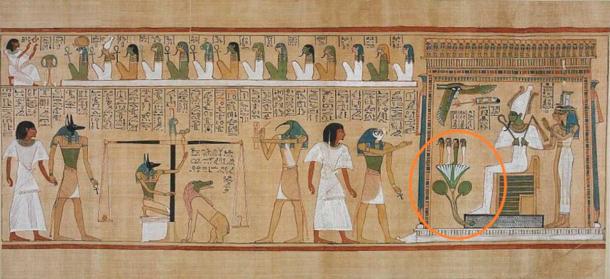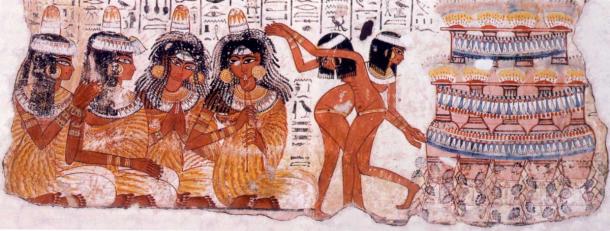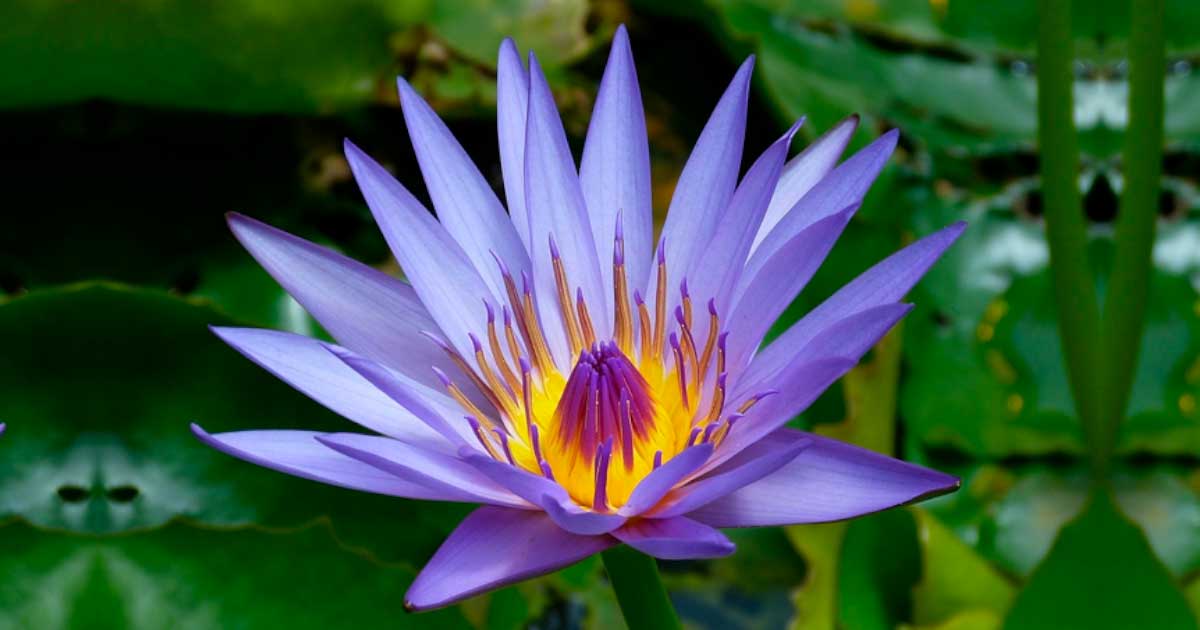The Blue Lotus: A Narcotic Lily That Mesmerized Ancient Egypt
A water lily from the genus Nymphaea, this plant became known as the ‘Blue Lotus’, or the ‘Egyptian Lotus’. This aquatic plant is not just a thing of beauty, it has a secret too, and the ancient Egyptians were very aware of it. A symbol of life and immortality, the blue lotus was believed to provide a spiritual connection into the afterlife and offer communication with the divine, as was mentioned even in the famous ‘Egyptian Book of the Dead’.
Entheogens and the Psychoactive Healing Properties of the Blue Lotus Flower
The Nymphaea Caerulea was considered a symbol of life and immortality in ancient Egypt, which used its entheogenic qualities to communicate with the divine. Entheogens are mind-altering substances that alter perception, behavior, and cognition of an individual. They are used often by spiritual and religious groups across the world, across cultures, to connect with a higher divinity. For example, the hallucinogen ayahuasca is used by indigenous peoples of the Amazon, as well as the mestizo (mixed race) shamans and members of Brazilian churches.
- Egyptian Hippos: Ancient Symbol of Protection, Rebirth and Hunting
- Cosmic oceans: the primordial waters of ancient creation myths
What worked in the flower’s favor was the roots being able to flourish in nutrient-deficient mud that lacks oxygen. The blue flowering species is small and round, and floats on top of lakes or bodies of water. Its flower buds rise to the surface over a two-to-three-day period, then open at around 9:30am and close in the early afternoon at 3:00pm when they reach maturity.
It has a storied history stretching thousands of years, across cultures as varied as Egypt, Maya, Syrian, Thai, to name a few, and is renowned for its intoxicating scent and inebriating effects. Originating in the Nile, variants of the blue lotus are grown in many countries today. It is also renowned for its medicinal qualities, which range from aphrodisia to pain alleviation, treating depression and anxiety, and even settling upset stomachs. It is also used to treat insomnia.
It contains two alkaloids - apomorphine and nuciferine. Apomorphine, a non-selective dopamine agonist, is primarily utilized in treating Parkinson's disease as it boosts dopamine receptors and improves motor function. Over the last 2 decades, it has emerged that apomorphine is an excellent treater of erectile dysfunction as well. On the other hand, nuciferine is known to block dopamine receptors.

A tomb painting representing Nebamun fishing and hunting. A bunch of lotuses hangs over his arm and another spray is held by his wife. The heads of the flowers are approximately triangular in shape, shown in profile with white petals framed by green and grey sepals. (© The Trustees of the British Museum/CC BY-NC-SA 4.0)
Ancient Egypt: Magic and Supernaturalism in the Everyday World
In ancient Egypt, religion, magic, and medicine were intertwined due to the belief that all aspects of life were influenced by the supernatural. To simplify life, a comprehensive corpus of texts was written that combined magic, medicine, and religion, including the famous "Egyptian Book of the Dead."

The Book of the Dead of Hunefer. (Public Domain)
In fact, The Egyptian Book of the Dead is one of the primary sources to study this plant, along with some papyri - the Ebers papyrus from 1500 BC in particular. The Ebers papyrus contains a mammoth 800 medical recipes and treatments, showcasing the vast knowledge Egyptians had of plants and medicines.
The Turin Papyrus shows the presence of sexually themed cults – secret temple gatherings of elite society, who shared sacred wines imbued with the blue lotus extract, a clear reference to its aphrodisiac qualities.
This religious scripture aimed to guide the deceased through the afterlife and achieve eternal life. The papyri contained information on various plants, remedies, spells, and healing methods accompanied by magical rituals such as incantations and invoking gods or goddesses.
In the case of the blue lotus, which was ‘the flower that resembled the Sun’, the Egyptians were enthralled for thousands of years. The captivating scent of the flower is depicted in various art forms, with people shown holding the flower to their noses to inhale its aroma. Additionally, chalices, often shown in tomb scenes and other artworks, suggest the use of the flower in libation rituals or other festivities.
The lotus symbolism present in this period reveals a great deal about the flower's usage in the religious life of ancient Egypt. Its depiction in various art forms and literature highlights the significance of the blue lotus in Egyptian culture and the impact it had on their beliefs and practices.
The Cult-Like Social Organization Around the Blue Lotus: A Preserve of the Elite?
The Egyptian Book of the Dead mentions and portrays the nymphaea plant in several chapters, always in relation to magical and religious rituals. In these depictions, the hallucinogenic plant mandragora, which has anticholinergic neurotransmitter blocker) properties, is often shown alongside the nymphaea. This highlights the knowledge the ancient Egyptians possessed about the effects of various plants, despite their lack of technology to explain it.
Tutankhamun’s tomb, for example, contained a gold-plated shrine decorated with a bas-relief of a pharaoh holding a giant nymphaeum and two mandragoras in his left hand. This indicates the importance of these plants in the lives of the pharaohs and the elites of ancient Egypt.
Frescoes from the tomb of Nebamun, now located in the British Museum, offer another glimpse into the use of nymphaea in ancient Egypt. These frescoes depict a ritualistic funeral dance with two male dancers accompanied by three women garlanded with blue lotus petals. The women are offering vases with golden emanations, as if they contain a magical fluid. This ritualistic dance is a testament to the importance of the Nymphaea plant in the religious and cultural practices of ancient Egypt.

Detail from a fresco from the tomb of Nebamun. Thebes, Egypt, Dynasty XVIII. In the collection of the British Museum, London. (Public Domain)
The Nymphaea species are also depicted in erotic cartoons and papyri (like the aforementioned Turin Papyrus), further emphasizing their cultural significance in ancient Egypt. However, the fact that temple drawings only show their use by higher castes such as priests and royalty, suggests that these plants and their effects were not accessible to common people. This is unsurprising given that a majority of historical finds do not depict the lives of everyday people.
The broader picture that the blue lotus story serves is a testament to the extensive knowledge of plant-based substances possessed by the ancient Egyptians. Despite the lack of technology to explain the effects of these substances, the Nymphaea plant was held in high esteem and played a significant role in their religious and cultural practices.
Top image: Water lily Nymphaea, known as ‘blue lotus’. Source: Public Domain
By Sahir Pandey
References
Bertol, E. et al. 2004. Nymphaea cults in ancient Egypt and the New World: a lesson in empirical pharmacology. Journal of the Royal Society of Medicine, 97(2). Available at: https://www.ncbi.nlm.nih.gov/pmc/articles/PMC1079300/.
Haddad, C.G. 2021. The Lily of the Nile: A work on the ritualistic use of an ancient flower of immortality. Uppsala University. Available at: http://www.diva-portal.org/smash/get/diva2:1560422/FULLTEXT01.pdf.
Hammond, C. 2021. Blue Lotus: The Ancient Egyptian Dream Flower. Available at: https://www.world-of-lucid-dreaming.com/blue-lotus-herb.html.
Kelly, C. 2017. BLUE WATER LILIES HOLD THE KEY TO A STUNNING, DIFFERENT HIGH. Available at: https://www.inverse.com/article/26125-blue-water-lily-lilies-stoned-high.




















Comments
The flowers of Nymphaea caerulea were probably what the “Lotus Eaters” offered to some of Odysseus’ companions, so that they became oblivious of their duty.
"The Turin Papyrus shows the presence of sexually themed cults – secret temple gatherings of elite society..."
It does more than that. It gives indirectly a reason why Ancient Egypt is so popular in history circles today and why modern elites are so taken with it that some have houses dedicated to it.
By the way, is it possible to write 'Nymphaea Caerulea' without the second capital? This is supposed to be a site where educated standards are kept.